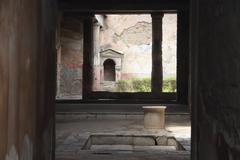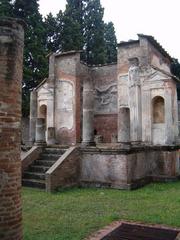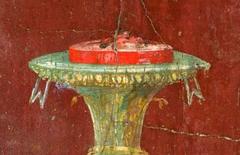Comprehensive Guide to Visiting Scavi di Pompei, Trecase, Italy
Date: 17/07/2024
Introduction
Scavi di Pompei, located near modern Naples in Italy’s Campania region, is one of the most extraordinary archaeological sites globally. This ancient Roman city, buried by the catastrophic eruption of Mount Vesuvius in 79 CE, provides an unparalleled glimpse into Roman life, architecture, and culture. Rediscovered in 1748, Pompeii offers visitors the unique opportunity to explore a city frozen in time, preserved under volcanic ash for nearly 1,700 years (Smithsonian Magazine).
This guide delves into the rich history of Pompeii, exploring its early settlement, Greek and Etruscan influences, and Roman urbanization. It also provides comprehensive visitor information, including ticket prices, opening hours, travel tips, and recommendations on guided tours and audio guides. Whether you’re a history enthusiast, an archaeology aficionado, or a curious traveler, this guide aims to prepare you for an unforgettable visit to one of Italy’s most significant historical sites.
Table of Contents
- Introduction
- History of Pompeii
- Visiting Pompeii Today
- Archaeological Significance
- Cultural and Social Insights
- Economic Importance
- Religious and Spiritual Life
- Technological and Engineering Marvels
- Preservation and Conservation Efforts
- Educational and Research Opportunities
- Tourism and Economic Impact
- Challenges and Future Prospects
- FAQ
- Conclusion
- References
History of Pompeii
Early Settlement and Development
Pompeii was founded in the 7th or 6th century BCE by the Oscans, an Italic tribe. Its strategic location on a plateau overlooking the Sarno River made it an attractive site for settlement and trade. The city quickly grew into a bustling port and trading hub, benefiting from its proximity to the Mediterranean Sea.
Greek and Etruscan Influence
During the 6th century BCE, Pompeii came under the influence of the Greeks and Etruscans. The Greeks, who had established colonies along the coast of southern Italy, brought their architectural styles, religious practices, and cultural traditions. This period saw the construction of significant structures, including temples dedicated to Greek gods such as Apollo and Hercules. The Etruscans, known for their advanced engineering and urban planning, also contributed to Pompeii’s infrastructure and layout.
Roman Conquest and Urbanization
In 310 BCE, Pompeii was conquered by the Romans, marking the beginning of a new era of prosperity and development. Under Roman rule, Pompeii underwent significant urbanization, with the construction of public buildings, roads, and aqueducts. The city was integrated into the Roman Republic and later the Roman Empire, becoming an important center for commerce and culture.
The Augustan Age
The Augustan Age (27 BCE - 14 CE) was a period of remarkable growth and transformation for Pompeii. Emperor Augustus initiated a series of public works projects that enhanced the city’s infrastructure and aesthetics. The Forum, the heart of Pompeii’s civic life, was expanded and adorned with statues and monuments. The construction of the amphitheater, capable of seating 20,000 spectators, and the large theater, which could accommodate 5,000 people, reflected the city’s vibrant social and cultural life.
The Eruption of Mount Vesuvius
On August 24, 79 CE, Pompeii’s fate was sealed by the catastrophic eruption of Mount Vesuvius. The eruption began with a massive explosion that sent a column of ash and pumice high into the sky. Within hours, the city was buried under a thick layer of volcanic material, preserving it in a state of suspended animation. The eruption lasted for two days, during which time the inhabitants of Pompeii were either killed by the pyroclastic flows or suffocated by the ash and gases.
Rediscovery and Excavation
Pompeii remained buried and forgotten for nearly 1,700 years until its accidental rediscovery in 1748 by a Spanish engineer named Rocque Joaquin de Alcubierre. Systematic excavations began in the mid-18th century, revealing a remarkably well-preserved city that provided an unprecedented glimpse into Roman life. The excavation of Pompeii has continued to this day, with archaeologists uncovering homes, shops, temples, and public buildings, along with a wealth of artifacts that offer insights into the daily lives of its inhabitants.
Significance of Pompeii
The significance of Pompeii lies in its unparalleled preservation, which has made it an invaluable resource for historians, archaeologists, and scholars. The city’s sudden burial under volcanic ash created a time capsule that has preserved buildings, frescoes, mosaics, and even graffiti in remarkable detail. This has allowed researchers to reconstruct the urban layout, architectural styles, and social dynamics of a Roman city.
Pompeii’s preservation has also provided insights into the daily lives of its inhabitants, from their diet and clothing to their religious practices and entertainment. The discovery of well-preserved bodies, known as “plaster casts,” has offered a poignant reminder of the human cost of the eruption, capturing the final moments of the victims in haunting detail.
Ongoing Research and Conservation
The excavation and conservation of Pompeii are ongoing efforts that continue to yield new discoveries and insights. Modern technology, including ground-penetrating radar and 3D imaging, has revolutionized the study of the site, allowing archaeologists to explore previously inaccessible areas and uncover hidden structures.
Conservation efforts are also crucial to preserving Pompeii for future generations. The site faces numerous challenges, including weathering, erosion, and the impact of tourism. International collaborations and funding have been instrumental in addressing these challenges and ensuring the long-term preservation of this unique archaeological treasure.
Visiting Pompeii Today
Key Attractions
Today, Pompeii is one of Italy’s most popular tourist destinations, attracting millions of visitors each year. The site offers a unique opportunity to step back in time and explore a Roman city frozen in time. Key attractions include the Forum, the amphitheater, the House of the Faun, and the Villa of the Mysteries, each offering a glimpse into the grandeur and complexity of ancient Pompeii.
Visitors can also explore newly opened areas, such as the House of the Vettii, which features stunning frescoes and intricate mosaics. Guided tours and audio guides are available to enhance the visitor experience, providing historical context and insights into the significance of the site.
Visitor Information
Tickets
Tickets to Pompeii can be purchased online or at the entrance. Prices vary, with discounts available for children, students, and seniors. As of 2024, the standard adult ticket price is €16, with reduced prices for EU citizens aged 18-25 and free entry for children under 18. For more information, visit the official Pompeii Archaeological Park website.
Opening Hours
Pompeii is open daily, with varying hours depending on the season. Generally, the site opens at 9:00 AM and closes at 7:30 PM during the summer months and 5:00 PM in the winter.
Travel Tips
- Getting There: Pompeii is easily accessible by train from Naples, with a direct route that takes about 30 minutes.
- What to Bring: Wear comfortable shoes, as the site is extensive and requires a lot of walking. Bring water and sun protection, especially during the summer. Consider visiting early in the morning or late in the afternoon to avoid the crowds.
- Guided Tours and Audio Guides: Guided tours are available in multiple languages and can be booked in advance. Audio guides are also available for rent at the entrance.
Archaeological Significance
The archaeological significance of Pompeii cannot be overstated. The site offers a unique snapshot of Roman civilization frozen in time. The preservation of buildings, artifacts, and even the remains of the inhabitants provides invaluable insights into the social, economic, and cultural aspects of Roman life. The city’s layout, with its streets, public buildings, private homes, and shops, offers a comprehensive view of urban planning in the Roman Empire (National Geographic).
Cultural and Social Insights
Pompeii provides a detailed look into the daily lives of its inhabitants. The preserved frescoes, mosaics, and graffiti offer insights into the artistic and cultural expressions of the time. The graffiti, in particular, reveals the thoughts, humor, and concerns of the people, ranging from political slogans to love declarations (BBC). The presence of public baths, theaters, and amphitheaters indicates the importance of social and recreational activities in Roman society.
Economic Importance
The economic significance of Pompeii is evident from the numerous shops, markets, and workshops uncovered during excavations. The city was a bustling commercial hub, with evidence of trade in goods such as wine, olive oil, and fish sauce. The discovery of bakeries, fulleries (laundries), and other businesses provides a detailed picture of the economic activities that sustained the city (History).
Religious and Spiritual Life
Pompeii was home to numerous temples and shrines dedicated to various Roman gods and goddesses, reflecting the religious diversity and spiritual life of its inhabitants. The Temple of Apollo, the Temple of Jupiter, and the Temple of Isis are among the significant religious structures that have been excavated. These temples not only served as places of worship but also played a crucial role in the social and political life of the city (Ancient History Encyclopedia).
Technological and Engineering Marvels
The engineering and technological advancements of Pompeii are evident in its sophisticated infrastructure. The city had an advanced water supply system, including aqueducts, public fountains, and private baths. The streets were paved and had a well-planned drainage system, showcasing the engineering prowess of the Romans. The construction techniques used in buildings, such as the use of concrete and the design of domes and arches, highlight the technological innovations of the time (ScienceDirect).
Preservation and Conservation Efforts
The preservation and conservation of Pompeii have been ongoing challenges due to the site’s exposure to natural elements and the sheer volume of visitors. Various international organizations, including UNESCO, have been involved in efforts to preserve the site. Modern technology, such as 3D scanning and digital reconstruction, has been employed to document and protect the ruins. These efforts are crucial in ensuring that future generations can continue to learn from and appreciate this invaluable historical site (UNESCO).
Educational and Research Opportunities
Pompeii serves as an open-air laboratory for archaeologists, historians, and researchers. The site offers endless opportunities for study and research, contributing to our understanding of ancient Roman civilization. Educational programs and collaborations with universities and research institutions worldwide have made Pompeii a focal point for academic study and scholarly research (Pompeii Sites).
Tourism and Economic Impact
Pompeii is one of Italy’s most popular tourist destinations, attracting millions of visitors each year. The site’s popularity has a significant economic impact on the local and national economy, generating revenue through tourism-related activities. The influx of tourists has also led to the development of infrastructure and services in the surrounding areas, contributing to the overall economic growth of the region (Statista).
Challenges and Future Prospects
Despite its significance, Pompeii faces several challenges, including environmental threats, vandalism, and the pressures of mass tourism. Addressing these challenges requires a balanced approach that ensures the preservation of the site while accommodating the needs of visitors. Future prospects for Pompeii include the continued use of technology in preservation efforts, the development of sustainable tourism practices, and ongoing research to uncover more about this fascinating ancient city (The Guardian).
FAQ
Q: What are the visiting hours for Pompeii?
A: Pompeii is typically open from 9 AM to 7 PM during the summer months and 9 AM to 5 PM in the winter. Always check the official website for the most current information.
Q: How much do tickets to Pompeii cost?
A: Standard tickets are generally around €16, while combined tickets that include additional sites are about €24. Discounts are available for students and seniors.
Q: How can I get to Pompeii from Naples?
A: Pompeii is easily accessible by train from Naples, with a direct route that takes about 30 minutes.
Conclusion
The history of Pompeii is a testament to the resilience and ingenuity of its inhabitants, as well as the destructive power of nature. Its preservation offers an unparalleled window into the past, allowing us to explore and understand the complexities of Roman life. As ongoing research and conservation efforts continue to uncover new discoveries, Pompeii remains a vital and dynamic site that continues to captivate and educate visitors from around the world.
Visiting Pompeii provides a unique opportunity to walk through history, explore well-preserved ruins, and gain a deeper understanding of Roman life. By following the travel tips and recommendations provided in this guide, you can make the most of your visit and immerse yourself in the fascinating world of Pompeii. For more information and updates on visiting Pompeii, be sure to check the official website and consider supporting the preservation efforts by purchasing souvenirs and participating in guided tours (UNESCO).
References
- Exploring Pompeii - History, Visiting Hours, Tickets, and Travel Tips, 2024, Pompeii Sites
- Discover the Significance of Pompeii - History, Tickets, Visiting Hours & More, 2024, Smithsonian Magazine
- Ultimate Guide to Visiting Scavi di Pompei - Tickets, Hours, Tips & More, 2024, UNESCO


